mySQL教程 第4章 数据查询
来源:互联网 发布:nginx 安全加固 编辑:程序博客网 时间:2024/04/29 04:51
第4章 数据查询
mySQL运算符
这些运算符在SQL查询中用得到。
算数运算符
+ 加
- 减
* 乘
/ DIV 除
% MOD 取余数
比较运算符
= 等于
<> != 不等于
<
<=
>
>=
Between 指定范围
In 存在于集合
Is null 为NULL
Is not null 不为空
Like 通配符
Regexp rlike 正则表达式
比如
比较运算符,返回的结果 真为1,假为0
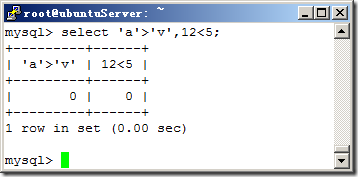
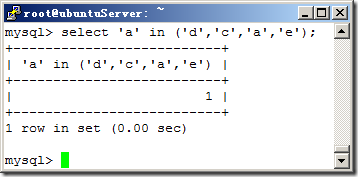

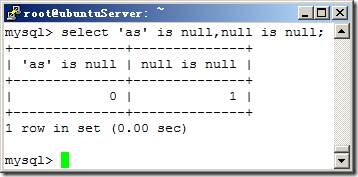

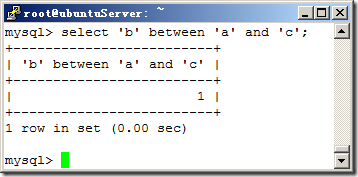
运算符优先级
最高------------------------------------------à最低
! () * / div % mod - + = <>= like between case when then else not and or
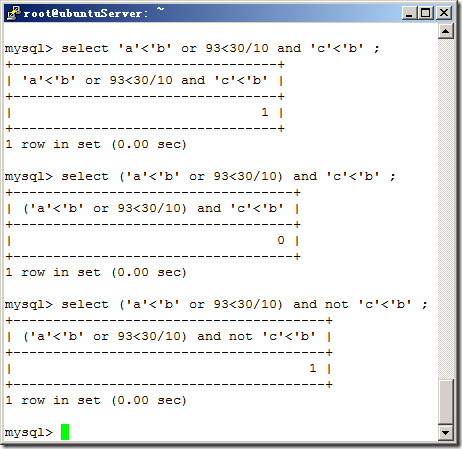
单表查询
查询所有列所有行
select * from TStudent
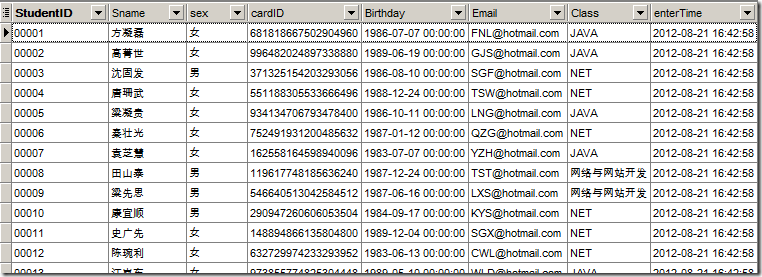
查询指定列
select studentID,Sname,Sex,cardID from TStudent
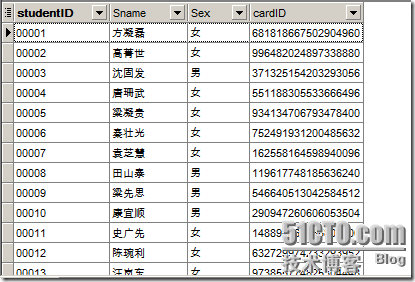
为列指定别名
select studentID 学号,Sname 姓名,Sex 性别,cardID ***号 from TStudent
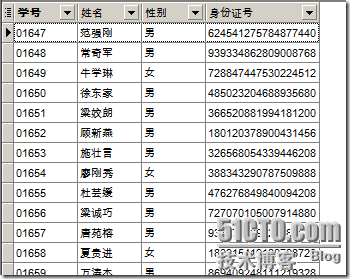
指定查询条件
查询条件中可以使用< > <= >= != 比较运算符
1. 查询网络班学生
select studentID 学号,Sname 姓名,Sex 性别,cardID ***号,class 班级
from TStudent where class='网络与网站开发'
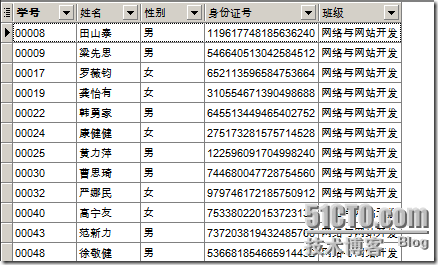
2. 查询网络班性别是女的学生
select studentID 学号,Sname 姓名,Sex 性别,cardID ***号,class 班级
from TStudent where class='网络与网站开发' and sex='女'
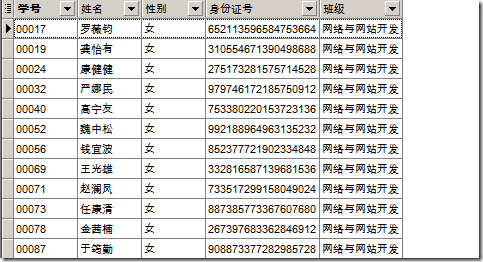
3. 查找软件测试班或性别是女的学生
select studentID 学号,Sname 姓名,Sex 性别,cardID ***号,class 班级 from TStudent where class='软件测试' or Sex='女'
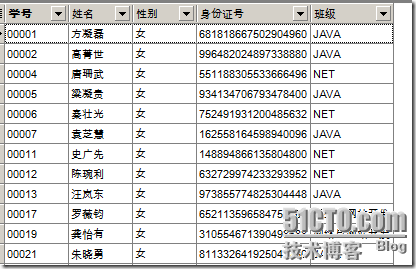
4. 使用like模糊查询
使用字符比较符 like
% 0个或多个字符串
_ 任何单个的字符
[]在指定区域或集合内的任何单个字符
[^]不在指定区域或集合内的任何单个字符
查找姓名中含有“立”字的学生
select studentID 学号,Sname 姓名,Sex 性别,cardID ***号,class 班级 from TStudent where Sname like '%茂%'
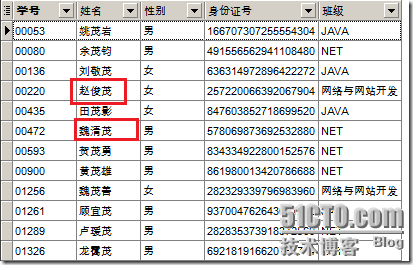
思考:查找姓名最后一个字是“茂”的同学,写出SQL语句。
5. 查找姓名是“韩立刚”,“韩旭”的学生
记下上面查询结果的两个名字。查找这两个名字的记录。
select studentID 学号,Sname 姓名,Sex 性别,cardID ***号,class 班级 from TStudent where Sname in ('赵俊茂','魏清茂')

6. 查找出1975年到1980年出生的学生
使用比较操作符 = > < >= <= <>
select studentID 学号,Sname 姓名,Sex 性别,cardID ***号,class 班级,Birthday 生日
from TStudent where Birthday>'1980' and Birthday<'1985'
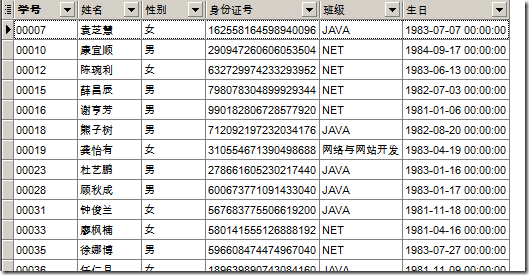
7. 使用关系运算符
关系运算符优先级 not and or 如下面的例子 去掉括号结果一样
select studentID 学号,Sname 姓名,Sex 性别,cardID ***号,class 班级,Birthday 生日
from TStudent where Birthday>'19820101' and Birthday<'19841230' or sex='女'
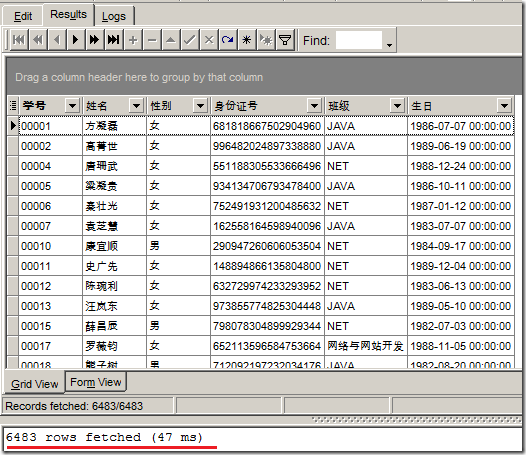
通过使用括号更运算顺序
select studentID 学号,Sname 姓名,Sex 性别,cardID ***号,class 班级,Birthday 生日
from TStudent where Birthday>'19820101' and (Birthday<'19841230' or sex='女')
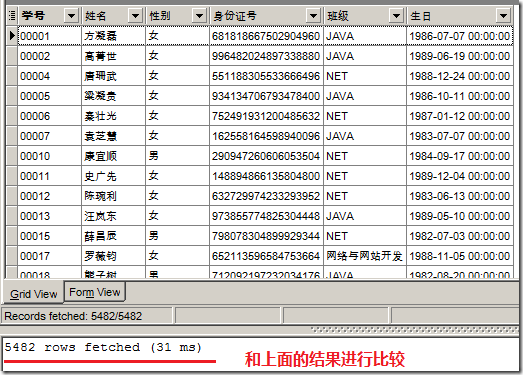
8. 查询在一定范围内的值
查找生日在1985年到1990年之间的学生
select studentID 学号,Sname 姓名,Sex 性别,cardID ***号,class 班级,Birthday 生日
from TStudent where Birthday BETWEEN '19850000' and '19860000'
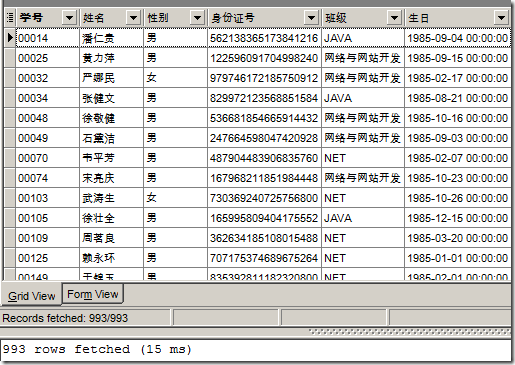
查找不在1985年到1986年出生的学生
select studentID 学号,Sname 姓名,Sex 性别,cardID ***号,class 班级,Birthday 生日
from TStudent where Birthday not BETWEEN '19850000' and '19860000'
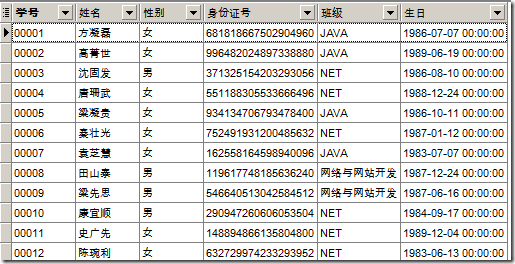
尽量使用between而不使用and和比较操作符表示的表达式
如果想返回不在指定区域的行时,使用not between。这样会降低数据查询的速度。
9. 查询空值
insert into TStudent (studentid,sname) values ('19999','张永超')
select * from TStudent where studentid='19999'

可以看到没有插入的列值为Null
select * from TStudent where cardID is NULL
![clip_image021[1] clip_image021[1]](http://img1.51cto.com/attachment/201302/22/400469_1361515928LgBW.png)
你绝不要这样写
select * from TStudent where cardID=''
使用is not null来查询指定列中非空的行
select * from TStudent where cardID is not NULL
格式化结果集
1. 排序
默认是降序 desc升序 asc 降序
select * from TStudent order by cardID

select * from TStudent order by cardID asc
按两列排序 先按班级排序 再按学号排序
select * from TStudent order by Class,studentid desc

以下命令就是按第7列和第1列排序,输出结果和以上的一样
select * from TStudent order by 7,1 desc
2. 消除重复的行
以下命令查看有几个班
select DISTINCT class 班级 from TStudent
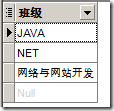
多表查询
在TStudent表插入两个学生
insert into TStudent values ('90006','张勇','男','132302198903044565','19880203','zhangyong@onest.net','JAVA','20120803');
insert into TStudent values ('90007','赵洁','女','132302198905044565','19880503','zhaojie@onest.net','JAVA','20120803')
这两个学生没有成绩
3. 使用Join内连接多张表
内连接使用inner关键字,可以省去。
没有成绩的学生没有列出来。
使用外键匹配可以讲多个表组成一张大表,可以看到组成的大表记录条数4个学生*2科
select a.*,b.*,c.* 分数 FROM `TStudent` a inner join `TScore` b on a.`StudentID`=b.`StudentID` inner join `TSubject` c on b.`subJectID`=c.`subJectID`

从以上三个表组成的大表找到计算机网络课程分数大于80分的记录
select sname 姓名,sex 性别,c.`subJectName` 学科,b.`mark` 分数 FROM `TStudent` a join `TScore` b on a.`StudentID`=b.`StudentID` join `TSubject` c on b.`subJectID`=c.`subJectID` where c.`subJectName`='计算机网络' and b.`mark`>80
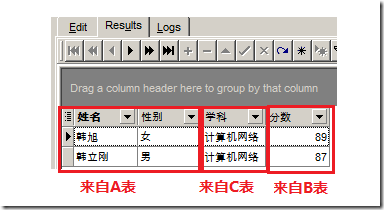
可以看到输出结果来自三张表
4. 左连接
做连接使用left有连接使用right
select a.*,b.* FROM `TStudent` a left join `TScore` b on a.`StudentID`=b.`StudentID`使用左连接可以看到没有成绩学生也出现在表中

思考:左连接
5. 自连接
自己连接自己,比如查找重名的学生
select a.studentid,a.sname,b.studentid,b.sname from TStudent a join TStudent b on a.sname=b.sname where a.studentid<>b.studentid
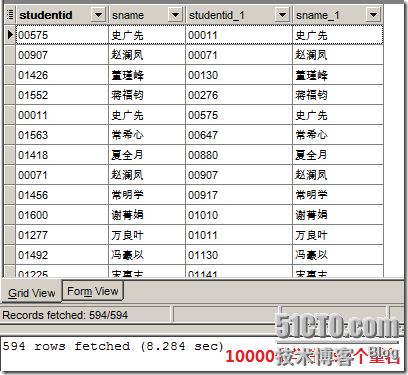
6. 使用子查询
使用子查询,输出结果只能来自一张表,其他表作为查询的条件。
为什么使用子查询---子查询可以把一个复杂的查询分解成一系列逻辑步骤,这样就可以用一个单个的语句解决复杂的查询问题。
为什么使用连接而不使用子查询---执行效力差不多,子查询可能要求查询优化器执行额外的操作,比如排序,而这些操作将会影响查询的处理策略。
select sname 姓名 from `TStudent` where Studentid in (select StudentID from `TScore` where mark>90)
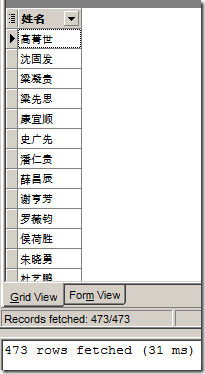
以下SQL语句子查询中又嵌套了子查询,查询计算机网络,输出结果只能来自一个表。
select sname 姓名 from `TStudent` where Studentid in (select StudentID from `TScore` where mark>90 and subjectID in (select subjectID from `TSubject` where subJectName='计算机网络'))
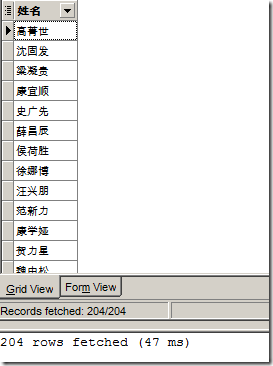
7. 使用any关键字
创建两个表
create table tb1 (num int not null);
create table tb2 (num int not null);
插入数据
insert into tb1 VALUES (2),(5),(13),(25),(32);
insert into tb2 VALUES (6),(8),(20),(43),(70),(4);
查找tb1,条件是只要值大于tb2的任何一个值就可以
select num from tb1 where num>any(select num from tb2)
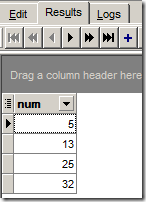
8. 使用关键字all
返回tb2所有值都小的值
select num from tb1 where num<all(select num from tb2)
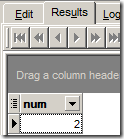
9. 使用exist关键字
如果成绩表中的分数有大于80分的记录,就返回TStudent表中的第一条记录
当然也可以使用not exist
select * from `TStudent` where EXISTS (select * from `TScore` where mark>80) limit 1

有大于100分的学生,就查出学生记录。
select * from `TStudent` where EXISTS (select * from `TScore` where mark>100) limit 1

10. 使用union合并查询结果
查找tb1和tb2大于40的数据
Select num from tb1 where num>40 union select num from tb2 where num>40
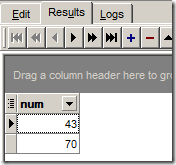
数据分组和汇总
11. Group by进行数据汇总
如果使用聚集函数,则将对表中的所有记录的某个字段进行汇总,然后生成单个的值。如果想生成多个汇总值,同时使用聚集函数和group by 语句,联合使用having和group by子句能够使结果集只包含满足条件的记录。
计算各个班“计算机网络”平均分
select a.Class 班级,AVG(b.`mark`) 计算机网络平均分 from `TStudent` a join `TScore` b on a.`StudentID`=b.`StudentID` join `TSubject` c on b.`subJectID`=c.`subJectID` where c.`subJectName`='计算机网络' group by a.`Class`

Group by 必须和集合函数结合使用
12. 联合使用group by子句与having子句
Having 相当于条件
查找计算机网络课程平均分大于80分的班级
select a.Class 班级,AVG(b.`mark`) 计算机网络平均分 from `TStudent` a join `TScore` b on a.`StudentID`=b.`StudentID` join `TSubject` c on b.`subJectID`=c.`subJectID` where c.`subJectName`='计算机网络' group by a.`Class` having AVG(b.`mark`)>75

13. 思考题:统计各个班级所有科目的总分。
14. 查询指定的行数
使用limit显示前2行数据
select StudentID,Sname,sex,cardID from `TStudent` limit 2

显示从第2条记录后面的3条记录
select StudentID,Sname,sex,cardID from `TStudent` limit 2,3
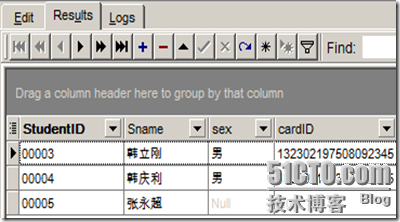
15. 使用聚集函数统计行数
Count函数不统计Null记录
select count(*) from `TStudent`;

select count(cardID) 登记了***的学生数量 from `TStudent`,没有登记***不统计。

16. 思考:统计男生数量
使用正则表达式
一个正则表达式中的可以使用以下保留字
符号
说明
^
所匹配的字符串以后面的字符串开头
$
所匹配的字符串以前面的字符串结尾
.
匹配任何字符(包括新行
a*
匹配任意多个a(包括空串)
a+
匹配任意多个a(不包括空串)
a?
匹配一个或零个a
de|abc
匹配de或abc
(abc)*
匹配任意多个abc(包括空串)
[a-dx]
匹配“a”、“b”、“c”、“d”或“x”
[^a-dx]
匹配除“a”、“b”、“c”、“d”、“x”以外的任何字符。“[”、“]”必须成对使用
17. 查询特定字符或字符串开头的记录
select sname,email from `TStudent` where email REGEXP '^KY'
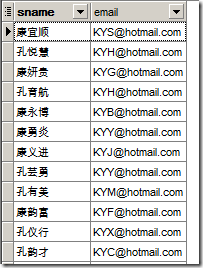
18. 查询以特定字符或字符串结尾的记录
select sname,email from `TStudent` where sname REGEXP '富$'
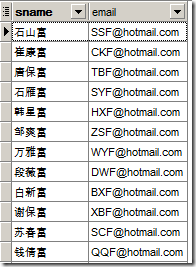
19. 使用*和+来匹配字符串中的多个字符
*匹配前面字符任意多次,包括0次,+匹配前面字符至少一次。
select sname,email from `TStudent` where email REGEXP '^TB*'
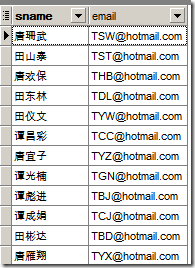
select sname,email from `TStudent` where email REGEXP '^TB+'
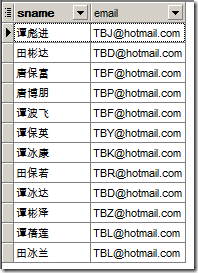
20. 匹配指定字符串
select sname,email from `TStudent` where email REGEXP 'BZ'

21. 匹配字符串的任意一个
select sname,email from `TStudent` where emai
l REGEXP '[BZ]'
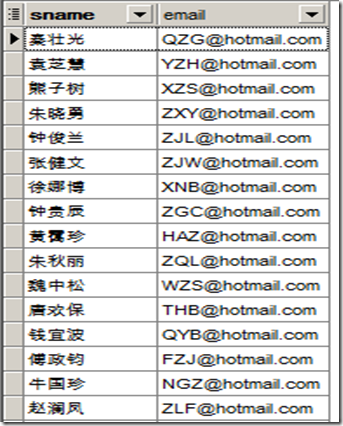
- mySQL教程 第4章 数据查询
- mySQL 教程 第3章 数据类型和数据完整性
- mySQL教程 第5章 插入 更新与删除数据
- 《MySQL入门很简单》学习笔记(10)之第10章查询数据(关键词:数据库/MySQL/查询数据)
- mysql查询第n到第m条数据
- 第7章 查询数据
- MySQL 学习教程(七)【整理】-数据的基本查询操作
- MySQL入门很简单-学习笔记 - 第10章 查询数据
- mysql 查询数据库中第n大数据的值
- 第11讲 mysql查询数据 并展示出来
- 如何Mysql查询这一年第X周的数据?
- MYSQL教程:查询篇
- Hibernate数据查询教程
- mySQL教程 第1章 数据库设计
- 《Drools7.0.0.Final规则引擎教程》第4章 Query查询之基础
- mySQL 教程 第2章 安装和介绍mySQL
- Mysql查询重复数据
- php查询MySQL数据
- mongodb性能优化
- mongodb中的数据建模
- mySQL教程 第1章 数据库设计
- mySQL 教程 第2章 安装和介绍mySQL
- mySQL 教程 第3章 数据类型和数据完整性
- mySQL教程 第4章 数据查询
- mySQL教程 第5章 插入 更新与删除数据
- mySQL教程 第7章 存储过程和函数
- mysql 在linux下安装错误的问题
- init 0-6 (启动级别:init 0,1,2,3,4,5,6)
- rabbitmq 在centos下的安装
- 图2:邻接表的详细解释(包含存储和求出度和入度)
- linux源码安装iostat,dstat,systat的方法
- linux下dstat监控


